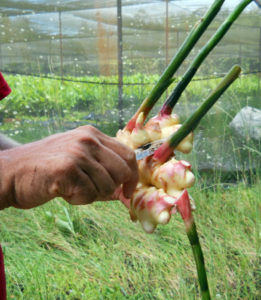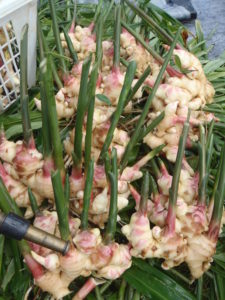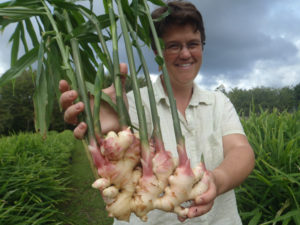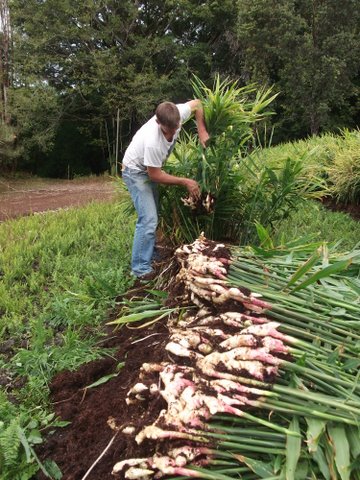Pretty in Pink: Grow Edible Ginger!
The sickle makes its way quickly and quietly through tall, healthy green foliage. The air smells pleasantly of ginger and earth. I hear the sound of roots giving way as Hugh Johnson and Dan Kelly pull hands of young ginger from the soil. Bright pink bud scales adorn the creamy white rhizomes of the freshly dug crop.
The farm I am visiting is Puna Organics on the Big Island of Hawaii. Baby Ginger is truly beautiful in paradise but it can grow well anywhere in the United States. Hugh and Dan are growing edible ginger. It is used as a spice, a medicinal herb, and flavors many teas, drinks and confections that we commonly consume. Current scientific literature points to ginger (and turmeric, the spice high in curcumins) as having cancer-fighting properties. These properties are owed to the phytochemical compounds in ginger, namely gingerols, shogaols and zingerone, that give ginger its spicy and medicinal qualities.
Aside from the anticarcinogen compounds in ginger, studies have proven that ginger is effective in treating nausea, motion sickness and morning sickness. Ginger, as well as turmeric, has long been used in Ayurvedic medicine (holistic and natural medicine of Hinduism that teaches healing and prolonging of life). Both of these rhizomes are easy to grow, cultivate and market. In addition to growing and marketing mature and immature edible ginger, Puna Organics is also growing seed ginger, much to the advantage of farmers on the mainland! This seed is certified organic, disease-free and ships from the farm in Hawaii right to those who order on the mainland that want to try their hand at a phenomenal crop. Hugh and Dan are always seeking new varieties of ginger.
Their newly developed Ruhi (pronounced Rue-hee, meaning “soul” in Urdu, it is the name of a poet friend of Hugh’s) is a selection Hugh made over the last 15 years of ginger from Indian origins. It initiates foliage growth quickly, makes larger rhizomes quicker and is, thus, more suited to the shorter season in the continental U.S.
Ruhi has the characteristic pink bud scales when harvested for baby ginger. At maturity the flesh is yellow at the growing tips with blue flesh at the base of the rhizome. Ruhi seed pieces will be readily available for the 2012 growing season. There are limited quantities of a Hawaiian yellow ginger and Thai ginger (galangal). Puna Organics also offers seed for turmeric — a variety that is robust in rhizome growth, yield, gingerols and curcumins… but that’s a whole other article in itself!
Ginger in the grocery store is grown to maturity for anywhere from nine to eleven months. The ginger that we can grow in the continental United States is harvested earlier, during the young stage of rhizome growth, at about 5-8 months (referred to as Baby Ginger or young ginger).Baby Ginger is delicious! It has the characteristic bite of ginger without being hot or overpowering. The texture is akin to hearts of palm, tender yet toothsome, because the thick skin and tough fibers running through it have not yet formed. In addition to all the other things that can be done with mature ginger, immature ginger can be pickled and candied. Ginger pickles are a splendid accompaniment to Sushi, cooked greens, grilled chicken, and grains. And, last but not least, the skin accented with neon pink scales, stands out like a beacon at market!
For these reasons Baby Ginger is highly appreciated by chefs and consumers alike and commands a high price. Baby Ginger is perishable and cannot be shipped all over the world like mature ginger, but is great purchased locally. It lasts about two weeks at room temperature after being harvested, washed and trimmed. After a couple weeks it will have lost it’s neon look but is still fine for processing or home use. It can be frozen for later use, too. Bring frozen rhizomes out of freezer to refrigerator to thaw for use of entire rhizome; otherwise, grate frozen rhizome into recipe and put right back into the freezer.
Ginger is susceptible to some diseases and it has cultural requirements that are different from typical vegetable crops. However, once the learning curve has been surpassed, and even during, there is a sense of tropical wonder when tending this crop. It might be the smell as one walks by the plants, it could be the rhizomes peeking out of the soil surface waiting to be hilled, or the splendor of pulling something pink out of the soil could be the climax for some. For most growers, though, the reaction that they get at market, from chefs, from wholesalers, is priceless. Customers stare in awe at the pink rhizomes and ask, “Is that ginger?
My visit to Puna Organics was simple — to learn the nuances of growing edible young ginger and pass it along to farmers on the mainland. Hugh Johnson has been farming organic ginger for nearly 20 years. Dan Kelly, his business partner, has been in the horticulture business for over a decade and working with Hugh for almost five years. Hugh and Dan together have forged a way to offer clean, organic ginger seed to the masses. Edible ginger is a delight; discover for yourself!






How much do u sell Thai Ginger for? I like to plant them. Organic. Please let me know. Thanks. I am in Oahu.
Hi
Do you sell and ship even to South Africa? I am just a housewife who would love to try growing my own ginder.
Regards
Kathy
Is that red ginger?
Hi Jahe,
You can find more information about the ginger at the East Branch Ginger website: http://eastbranchginger.com/. You can also contact the author Susan Anderson at 207-313-4358.
Hello trying to get in touch with Susan, my name is Dylan Moro, thanks